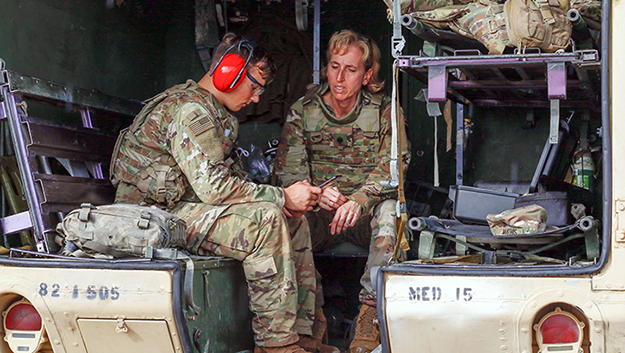A new portable hearing test technology advanced by Department of Defense researchers is capable of assessing and diagnosing hearing health far forward on the battlefield, as well as in a clinic setting, vastly improving access to care and enabling quicker diagnosis and treatment of injury.
The aptly dubbed "boothless" technology can take audiometry out of the traditional sound booth to meet service members where hearing injuries are most likely to occur.
The initial prototype project, called the Integrated Platform for Clinical Assessment and Monitoring, is the result of a Defense Health Agency Hearing Center of Excellence research effort, led by Dr. Douglas Brungart, from the National Military Audiology and Speech Center at Walter Reed National Military Medical Center in Bethesda, Maryland; and conducted in collaboration with the U.S. Army Medical Research and Development Command and the Army Public Health Center. HCE is a division of the DHA Research and Development Directorate.
The Wireless Automated Hearing Test System, or WAHTS, consists of a headset, a computer tablet or laptop with custom hearing-related software and an integrated dosimeter.
Dr. Theresa Schulz, HCE's prevention and surveillance branch chief, explained that the military services are pilot-testing boothless audiometry in a variety of remote environments to determine future viability of the technology.
As part of a proof of concept effort, the Army recently deployed an active-duty audiologist overseas with boothless technology, yielding excellent results, according to Schulz. As a result, it is now being considered for implementation in multiple settings, such as point-of-injury care in remote locations and military operational environments.
According to Schulz, a combat medic trained to use boothless audiometry can deliver hearing care at the lowest level of care (point of injury) to the highest (advanced trauma) within the military deployed theater of operations. Point of injury hearing care can help to facilitate immediate treatment and appropriate triage of service members who require more comprehensive hearing care, Schulz explained.
"Boothless audiometry enables audiologists to conduct hearing tests without a traditional sound booth," said Schulz. "It can be used to conduct hearing screenings and diagnostic audiometry in military deployed environments, as well as pharmacy waiting areas, in-patient care settings, and primary care clinics that don't typically have sound booth facilities. It can help identify significant hearing loss early, supporting timelier referral for comprehensive audiological services to treat and prevent additional hearing loss."
By providing hearing health services during primary care patient encounters, Schulz noted it is possible to increase patient-provider satisfaction and improve treatment outcomes in general.
Moreover, early identification of hearing loss for service members is a readiness item of interest, according to the DOD. Of more than 425 DOD military hospitals and clinics only 102 of them have audiology services, leaving beneficiaries at the other 323 to rely on their local TRICARE service providers for their hearing services.
Schulz emphasized boothless audiometry can help to bridge this gap, and increase access to hearing health care services.
For providers who treat patients with diabetes mellitus, the boothless system is showing promise as a way to early identify hearing loss, which is twice as common in adults with diabetes compared to those without the condition, according to a National Institutes of Health study.
Schulz emphasized boothless audiometry can help to bridge this gap, and increase access to hearing health care services.
For providers who treat patients with diabetes mellitus, the boothless system is showing promise as a way to early identify hearing loss, which is twice as common in adults with diabetes compared to those without the condition, according to a National Institutes of Health study.
From austere and remote environments, to clinic settings and beyond, boothless audiometry is proving to have multiple applications and value for future hearing health care.





Read Comments